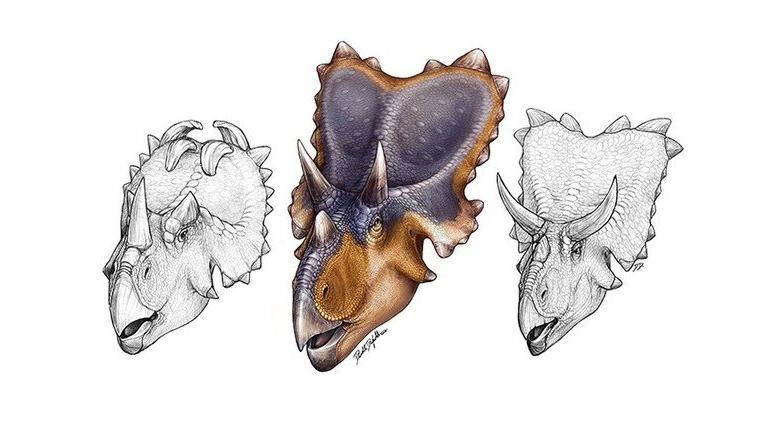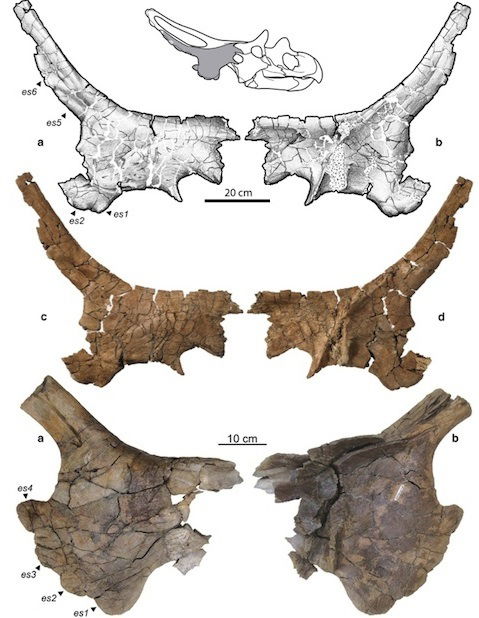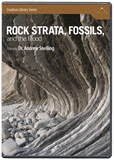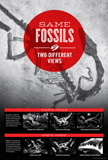
Mercuriceratops Delivers a Message from the Past
News to Know
Abstract
Does Mercuriceratops, like its mythological namesake messenger of the gods, bring us a mythological message from an evolutionary past?
News Source
Sporting wing-like frills on the side of its head, Mercuriceratops gemini, like its winged messenger namesake among the gods of classical mythology, is said to deliver a new chapter to the evolutionary history of horned dinosaurs in North America. The fossil record of this diverse group of big Cretaceous herbivores just got more diverse, surprising many evolutionists searching for the hidden evolutionary message in the twin finds.

Mercury was the “messenger of the gods” in classical mythology. Having wings on his head and feet, he has provided the name for Mercuriceratops, the newly discovered cousin of the mighty Triceratops, because its skull sported a hatchet-shaped, wing-like protrusion from the side of its skull. Image by Shuishouyue, via Wikimedia Commons.
New Cretaceous Critters
Designated “gemini” because virtually identical fossils were found about 380 km (over 230 miles) apart in Alberta, Canada’s lower Dinosaur Park Formation and Montana’s upper Judith River Formation, Mercuriceratops is named after Mercury the mythological messenger of the gods who is depicted with wings on his helmet and feet. We don’t know whether Mercuriceratops had any ornaments on its feet, of course, since to date the only bones recovered are these squamosal bones from the temporal region of the skull. Most other horned dinosaurs have flat or smooth squamosal bones on the sides of their heads, but this one has a side-jutting protrusion. And of course having two examples of the bone suggests to evolutionists that they come from an undiscovered species and are not just a single anomalous specimen.
The shape of the two bones (sans the “wing”), both from Upper Cretaceous (Campanian) rock layers, match corresponding bones in other horned dinosaurs, so paleontologists classify Mercuriceratops in the horned dinosaur family Ceratopsidae. The Ceratopsidae are best represented in fossils found in western North America. The massive members of this dinosaur family typically have horns above their eyes, beak-like mouths, and frills on the back of their necks. Conventionally dated about 77 million years ago based on their presence in Upper Cretaceous rock, they are divided into two subfamilies based in part on the shape of bones supporting the frills. Species are designated based on nuances in frill shape.
Frills on Frills
Because its squamosal bones are elongated and more-or-less triangular like those of the well-known Triceratops, Mercuriceratops joins its cousin in the subfamily Chasmosaurinae. Dinosaurs in the other subfamily, Centrosaurinae, have shorter, elaborate, more rectangular-shaped frills. However, the hatchet-shaped wing-like protrusion to the side of the Mercuriceratops skull has characteristics that fit both subfamilies. Finding this seemingly transitional species in two locations so far apart has, evolutionists say, provided exciting new information about the evolution of horned dinosaurs while they continue to speculate about the selective advantage that might have prompted the little “wings” to develop in these types of dinosaurs.
The authors of the report write, “With its hatchet-shaped lateral margin, the structure of the frill of Mercuriceratops demonstrates unexpected disparity in cranial shape among ceratopsid dinosaurs” and add, “In some ways, the morphology bridges the morphological gap”3 between the ancestral, more rectangular squamosals of centrosaurines and elongated triangular squamosals of chasmosaurines. They nevertheless believe that Mercuriceratops is not a transitional form and has a unique shape that “sets it apart from all other ceratopsids”4 because “this hypothetical evolutionary transition series is not reflected in the available ontogenetic series for Chasmosaurus from the Dinosaur Park Formation, in which even the smallest squamosals have a triangular shape.”5

All three of these drawings depict horned ceratopsid dinosaurs from the Dinosaur Park Formation in Alberta, Canada. Centrosaurus (left) and Chasmosaurus (right) represent the two subfamilies of ceratopsids. Unlike any other known ceratopsid, the newly discovered Mercuriceratops (center) had a wing-like projection from the side of its frill. Image by Danielle Dufault, via Los Angeles Times.6
Pretty Like a Peacock
“Mercuriceratops took a unique evolutionary path that shaped the large frill on the back of its skull into protruding wings like the decorative fins on classic 1950s cars. It definitively would have stood out from the herd during the Late Cretaceous,” says Cleveland Museum of Natural History paleontologist Michael Ryan, lead author of the paper published in Naturwissenschaften. Suggesting a purpose that might have played into a selective evolutionary advantage, Ryan says, “Horned dinosaurs in North America used their elaborate skull ornamentation to identify each other and to attract mates—not just for protection from predators. The wing-like protrusions on the sides of its frill may have offered male Mercuriceratops a competitive advantage in attracting mates.” Coauthor David Evans of the Royal Ontario Museum adds, “The butterfly-shaped frill, or neck shield, of Mercuriceratops is unlike anything we have seen before. Mercuriceratops shows that evolution gave rise to much greater variation in horned dinosaur headgear than we had previously suspected.”
Like the supposed selective advantage offered by peacock plumage, evolutionists generally assume the frills on horned dinosaurs existed to thrill and enthrall female dinosaurs, for they are generally too fragile to have served a defensive purpose. The little “wings” may have simply served as a way for dinosaurs to recognize each other, though we really have no way of knowing since dinosaurs are not seeking herd recognition or mates today.
Mega Bonebed
Regardless of the function these ornamental sidebars served—if they even had a function—the existence of variations like this among the horned dinosaurs is not evidence of evolutionary development but only the kinds of variation we might expect among the family of horned dinosaurs. Dinosaurs, created on the sixth day of Creation Week about 6,000 years ago, would have had the capacity to vary within their created kinds, leading to the production of great biodiversity in the nearly 1,700 years that passed before the global Flood wreaked havoc on the earth.

Mercuriceratops would have weighed about two tons but is known only from these two fossils, each a bone from the side of the skull. Because the bones fit into the place as indicated on the uppermost sketch, paleontologists determine that each came from a cousin of the Triceratops. The top photographs and line drawings show each surface of fossil ROM 64222, which was found in Montana’s Judith River Formation. The lower photographs are of UALVP 54559, which was found in the Dinosaur Park Formation, the largest known dinosaur bonebed. These nearly identical bones are from the same species. Unlike any other ceratopsid dinosaur, this species had a wing-like protrusion (see es1, es2, es3, and es4) sticking out from each side of its skull. Image: Michael Ryan et al., “A new chasmosaurine from northern Laramidia expands frill disparity in ceratopsid dinosaurs,” Naturwissenschaften, doi:10.1007/s00114-014-1183-1.
The Dinosaur Park Formation, where one of these specimens was found, was discovered in 2010 by scientists from the Royal Tyrrell Museum. This massive fossil graveyard, nearly a square mile in area, is far too extensive to be explained by local floods. Its discoverers believe violent tropical storms dumped huge loads of sediment on this inland region. The bonebed is the final resting place of many fossilized land animals like the huge Triceratops. They are generally very well preserved, just as we would expect when loads of water borne sediment were catastrophically dumped atop them.
This mega-bonebed—the largest dinosaur bonebed on record—is a testimony to the true message of Mercuriceratops—the story of how it came to be buried. Answers in Genesis geologist Dr. Andrew Snelling explains:
A mega bonebed of this scale with the catastrophically buried remains of thousands of large horned dinosaurs requires a mega-scale explanation. At least the scientists at Alberta’s Royal Tyrrell Museum have admitted the evidence favors catastrophic flooding of a vast landscape by powerful hurricane-force storms.
However, they fail to comprehend their own description of how vast a landscape was being catastrophically inundated on a continent-wide scale. Dinosaur fossil beds are found in a continuous arc from Alberta, Canada, stretching through Montana, Wyoming and Utah south into Mexico. So the whole North American continent was being flooded by rising ocean waters driven by catastrophic hurricane-force storms. Due to the apparent sudden impact, it is no wonder the carnage can only be described as breathtaking. There was no high ground to escape to, and it is unlikely that these animals could have treaded water for very long. Carcasses were deposited in clumps of smashed bones and rapidly buried before the rotting carcasses could be destroyed by scavengers.
Such descriptions are exactly what we would expect to find as evidence left behind by the Genesis Flood. Raging waters powered by hurricane-force storms as “the fountains of the great deep” gushed voluminous quantities of hot waters from inside the earth and torrential rain poured down through the opened “windows of heaven” (Genesis 7:11). These floodwaters rapidly rose, surging up and progressively across all the world’s continental land surfaces in waves due to repeated devastating earthquake-generated tsunamis modulated by resonating monster global tides.
Late in the ascending waters phase (the first 150 days) of the Flood, after many marine fossil-bearing sedimentary layers had been deposited beneath them, these dinosaur herds were likely moving along the western edge of the North American continent, trying to survive. But they wouldn’t have been able to escape the rising raging waters, as “all the high hills under the whole heaven were covered” so that “all flesh died in whose nostrils was the breath of life” (Genesis 7:19–22). Such was the carnage and the speed of burial the bones from these herds of dinosaurs were preserved for us today as a reminder of this devastating global Flood, and a warning that God judges man’s sin. Sadly, the Museum’s paleontologists did not read correctly the message of these dinosaur fossils that is so powerfully consistent with God’s eyewitness account in Genesis of this earth-shaking and reshaping event.
Themes and Variations
By the time of the global Flood, a great deal of biodiversity would have existed, and the layers of fossils that were frozen in time during that disaster attest to this reality. Baraminologists generally find that the most likely classification corresponding to “created kinds”—based on many criteria—is generally at around the “family” level. Mercuriceratops was evidently part of the diverse group of horned dinosaurs. But there is no evolutionary mystery about it. Mercuriceratops, like all other animals extinct and extant, is simply a descendant of one of the original kinds of dinosaurs God created about 6,000 years ago. Which other ceratopsids it perhaps could have interbred with we can never know, but among living animals it is clear that many very different-looking animals—like dog varieties—are able to interbreed freely and are likewise just variations of the same kind of animal.
The Message
And what is the “message” we should take from Mercuriceratops? Just as the great fossil graveyards remind us that sin must be judged by a holy God, so we must not forget the flip side of that lesson: our Creator is a God of grace. Noah, a sinner like us, “found grace in the eyes of the Lord” (Genesis 6:8) and was spared through the Flood. Jesus Christ, the Son of God and our Savior, has by bearing the penalty for all our sin on the Cross (2 Corinthians 5:21), made salvation from sin’s guilt and eternal penalty available to all who repent and trust Him. And that is surely a message (John 3:16–18) from the Word of the one true God worth repeating!
Further Reading
- ICR.org: Canadian ‘Mega’ Dinosaur Bonebed Formed by Watery Catastrophe
- Triceratops Tally up to Four in New Wyoming Dinosaur Graveyard
- Created Kinds (Baraminology)
- The Beauty of the Peacock Tail and the Problems with the Theory of Sexual Selection
- Evolution Through the Eye of the Beholder
For More Information: Get Answers
Remember, if you see a news story that might merit some attention, let us know about it! (Note: if the story originates from the Associated Press, FOX News, MSNBC, the New York Times, or another major national media outlet, we will most likely have already heard about it.) And thanks to all of our readers who have submitted great news tips to us. If you didn’t catch all the latest News to Know, why not take a look to see what you’ve missed?
(Please note that links will take you directly to the source. Answers in Genesis is not responsible for content on the websites to which we refer. For more information, please see our Privacy Policy.)
Footnotes
- Among living animals, tremendous variation may mark members of the same species, as we see in dogs, but evolutionary paleontologists generally classify all variations as distinct species, a practice somewhat justified by the impossibility of knowing which ones could freely interbreed.
- Michael J. Ryan et al., “A New Chasmosaurine from Northern Laramidia Expands Frill Disparity in Ceratopsid Dinosaurs,” Naturwissenschaften 101, no. 6 (2014): 505–512, doi:10.1007/s00114-014-1183-1.
- Ibid.
- Ibid.
- Ibid.
- Amina Khan, “Mercuriceratops: With Bony Wings on Its Skull, Dinosaur Looked Fly,” Los Angeles Times, June 18, 2014, http://www.latimes.com/science/sciencenow/la-sci-sn-new-dinosaur-mercuriceratops-triceratops-20140618-story.html.
- Alta Drumheller, “Alberta Scientists Discover Largest Bed of Dinosaur Bones,” The Globe and Mail, June 18, 2010, http://www.theglobeandmail.com/technology/science/alberta-scientists-discover-largest-bed-of-dinosaur-bones/article1373331/.
Recommended Resources

Answers in Genesis is an apologetics ministry, dedicated to helping Christians defend their faith and proclaim the good news of Jesus Christ.
- Customer Service 800.778.3390
- © 2024 Answers in Genesis





